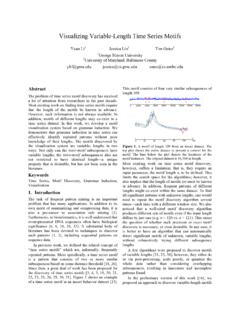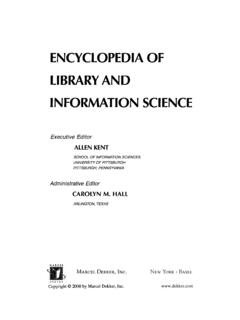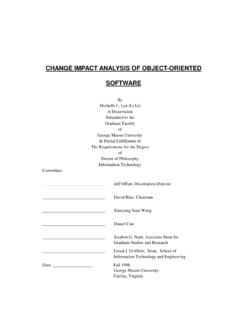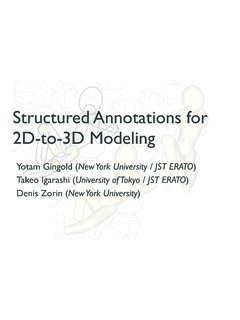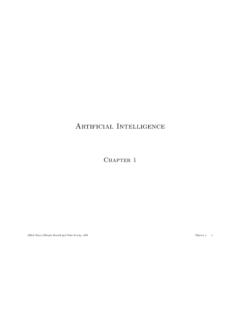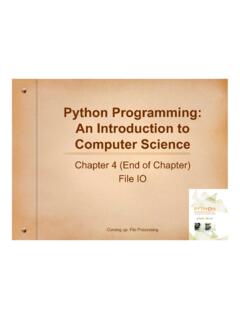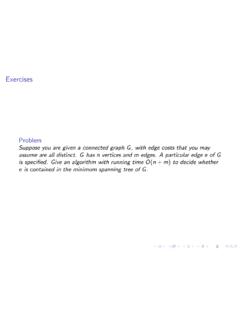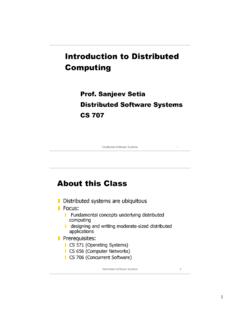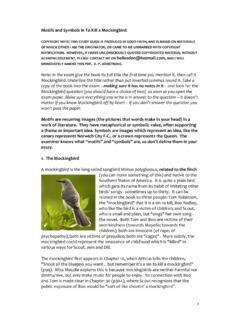Transcription of Finding Motifs in Time Series - George Mason University
1 Finding Motifs in time Series Jessica Lin Eamonn Keogh Stefano Lonardi Pranav Patel University of California - Riverside Computer Science & Engineering Department Riverside, CA 92521, USA {jessica, eamonn, stelo, ABSTRACT The problem of efficiently locating previously known patterns in a time Series database ( , query by content) has received much attention and may now largely be regarded as a solved problem. However, from a knowledge discovery viewpoint, a more interesting problem is the enumeration of previously unknown, frequently occurring patterns. We call such patterns Motifs , because of their close analogy to their discrete counterparts in computation biology. An efficient motif discovery algorithm for time Series would be useful as a tool for summarizing and visualizing massive time Series databases.}
2 In addition, it could be used as a subroutine in various other data mining tasks, including the discovery of association rules, clustering and classification. In this work we carefully motivate, then introduce, a non-trivial definition of time Series Motifs . We propose an efficient algorithm to discover them, and we demonstrate the utility and efficiency of our approach on several real world datasets. 1. INTRODUCTION The problem of efficiently locating previously defined patterns in a time Series database ( , query by content) has received much attention and may now be essentially regarded as a solved problem [1, 8, 13, 21, 22, 23, 35, 40]. However, from a knowledge discovery viewpoint, a more interesting problem is the detection of previously unknown, frequently occurring patterns.
3 We call such patterns Motifs , because of their close analogy to their discrete counterparts in computation biology [11, 16, 30, 34, 36]. Figure 1 illustrates an example of a motif discovered in an astronomical database. An efficient motif discovery algorithm for time Series would be useful as a tool for summarizing and visualizing massive time Series databases. In addition, it could be used as subroutine in various other data mining tasks, for instance: The discovery of association rules in time Series first requires the discovery of Motifs (referred to as primitive shapes in [9] and frequent patterns in [18]). However, the current solution to Finding the Motifs is either high quality and very expensive, or low quality but cheap [9]. Several researchers have advocated K-means clustering of time Series databases [14], without adequately addressing the question of how to seed the initial points, or how to choose K.
4 Motifs could potentially be used to address both problems. In addition, seeding the algorithm with Motifs rather than random points could speed up convergence [12]. Several time Series classification algorithms work by constructing typical prototypes of each class [24]. While this approach works for small datasets, the construction of the prototypes (which we see as Motifs ) requires quadratic time , as is thus unable to scale to massive datasets. In this work we carefully motivate, then introduce a non-trivial definition of time Series Motifs . We further introduce an efficient algorithm to discover them. 0 50010001500 2000 2500A B A 0204060 80 100120B C C Permission to make digital or hard copies of all or part of this work forpersonal or classroom use is granted without fee provided that copies arenot made or distributed for profit or commercial advantage and thatcopies bear this notice and the full citation on the first page.
5 To copyotherwise, or republish, to post on servers or to redistribute to lists,requires prior specific permission and/or a fee. SIGKDD 02, July 23-26, 2002, Edmonton, Alberta, Canada. Copyright 2002 ACM 1-58113-567-X/02 $ Figure 1: An astronomical time Series (above) contains 3 near identical subsequences. A zoom-in (below) reveals just how similar to each other the 3 subsequences are. The main advantage of our algorithm is that of providing fast exact answers, and even faster approximate answers. The rest of this paper is organized as follows. In Section 2 we formally define the problem at hand. In Section 3 we introduce a novel low-dimensional discrete representation of time Series , and prove that it can be used to obtain a lower bound on the true Euclidean distance.
6 Section 4 introduces our motif- Finding algorithm, which we experimentally evaluate in Section 5. In Section 6 we consider related work, and finally in Section 7 we draw some conclusions and highlight directions for future work. 050 100 150 200250 300 350 400450 500C Trivial Match Trivial Match 2. BACKGROUND The following section is rather dense on terminology and definitions. These are necessary to concretely define the problem at hand, and to explain our proposed solution. We begin with a definition of our data type of interest, time Series : Definition 1. time Series : A time Series T = t1,..,tm is an ordered set of m real-valued variables. time Series can be very long, sometimes containing billions of observations [15]. We are typically not interested in any of the global properties of a time Series ; rather, data miners confine their interest to subsections of the time Series [1, 20, 23], which are called subsequences.
7 Definition 2. Subsequence: Given a time Series T of length m, a subsequence C of T is a sampling of length n < m of contiguous position from T, that is, C = tp,..,tp+n-1 for 1 p m n + 1. A task associated with subsequences is to determine if a given subsequence is similar to other subsequences [1, 2, 3, 8, 13, 19, 21, 22, 23, 24, 25, 27, 29, 35, 40]. This idea is formalized in the definition of a match. Definition 3. Match: Given a positive real number R (called range) and a time Series T containing a subsequence C beginning at position p and a subsequence M beginning at q, if D(C, M) R, then M is called a matching subsequence of C. The first three definitions are summarized in Figure 2, illustrating a time Series of length 500, and two subsequences of length 128.
8 Figure 2: A visual intuition of a time Series T (light line), a subsequence C (bold line) and a match M (bold gray line) For the time being we will ignore the question of what specific distance function to use to determine whether two subsequences match. We will repair this omission in Section The definition of a match is rather obvious and intuitive; but it is needed for the definition of a trivial match. One can observe that the best matches to a subsequence (apart from itself) tend to be the subsequences that begin just one or two points to the left or the right of the subsequence in question. Figure 3 illustrates the idea. Figure 3: For almost any subsequence C in a time Series , the best matches are the trivial subsequences immediately to the left and right of C Intuitively, any definition of motif should exclude the possibility of over-counting these trivial matches, which we define more concretely below.
9 Definition 4. Trivial Match: Given a time Series T, containing a subsequence C beginning at position p and a matching subsequence M beginning at q, we say that M is a trivial match to C if either p = q or there does not exist a subsequence M beginning at q such that D(C, M ) > R, and either q < q < p or p < q < q. We can now define the problem of enumerating the K most significant Motifs in a time Series . Definition 5. K- Motifs : Given a time Series T, a subsequence length n and a range R, the most significant motif in T (called thereafter 1-Motif) is the subsequence C1 that has the highest count of non-trivial matches (ties are broken by choosing the motif whose matches have the lower variance). The Kth most significant motif in T (called thereafter K-Motif) is the subsequence CK that has the highest count of non-trivial matches, and satisfies D(CK, Ci) > 2R, for all 1 i < K.
10 Note that this definition forces the set of subsequences in each motif to be mutually exclusive. This is important because otherwise the two Motifs might share the majority of their elements, and thus be essentially the same. Figure 4 illustrates the need for this condition on a simple set of time Series projected onto 2-D space. 0 50 100 150 200 250 300 350 400 450 500C T M 1 - Motif 2-Motif 1 - Motif 2-MotifD(CK, Ci) > R D(CK, Ci) > 2R RA B Figure 4: A visual explanation of why the definition of K-Motif requires that each motif to be at least 2R apart. If the Motifs are only required to be R distance apart as in A, then the two Motifs may share the majority of their elements. In contrast, B illustrates that requiring the centers to be at least 2R apart insures that the Motifs are unique.
